ADDENDUM NOV. 3, 2013 (yes, 2013!):When I originally uploaded
this four-page entry it had been two and a half months since I last uploaded an entry from
our Alaskan adventure. It was a summary of our Alaska trip from the day
we entered the state (June 13) till September 1.
I apologized and encouraged readers to look at the topics page
periodically to at least see where we were.
Now I've finally caught up to this page and I will keep it mostly
intact. It's a handy summary of our Alaska adventure up to this point
with just six more days until we left the state. I have just a few more
Alaska entries to write (more than a year later -- sorry) and
that part of our Alaska journal will be complete.
Then I'll post entries about our return trip through Canada and what
we did in the Lower 48 before returning to our house in Virginia.
BACK TO WHAT I ORIGINALLY UPLOADED ON SEPT. 1, 2012
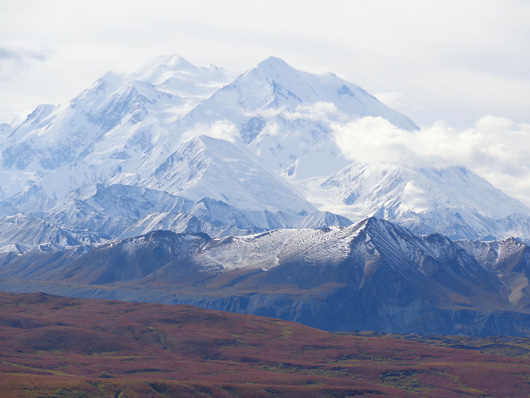
What I wanted to see more than
anything else in Alaska -- 20,320-foot Denali AKA Mt. McKinley, the
highest peak in North America.
We had opportunities to see it on several days from several locations.
I took this photo a few days ago
from 35 miles away at Eielson Visitor Center in Denali NP. (8-29-12)
This week we've had more rain than sun, giving me the perfect excuse to
go back through thousands of photos we've taken since we arrived in the
Frontier State in mid-June.
This series of entries is a collection of
some of my favorite photos from Alaska. They represent a variety of
places we've visited on our Virgin Tour of the state -- Anchorage
and its surrounding mountains and coast, the Mat-Su Valley, Valdez, the Kenai Peninsula (Turnagain
Arm, Portage Valley, Seward, Russian River, Soldotna, Homer, etc.), and Denali
state and national parks.
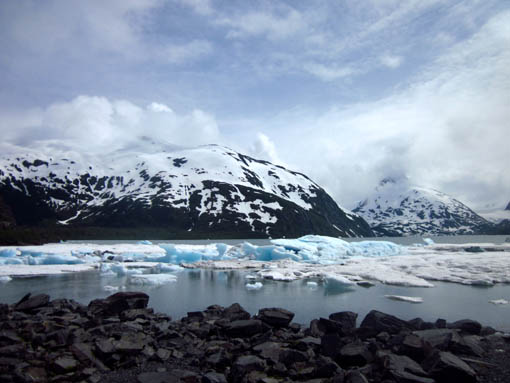
Small blue icebergs from nearby Portage Glacier
float on the lake next to the Begich-Boggs
Visitor Center in the Portage Valley at the eastern
end of Turnagain Arm. (6-27-12)
Some of Alaska's thousands of glaciers are
accessible by vehicle or foot, others by plane or boat.
These photos are a small sample of the scenic views, wildlife, and
historical/cultural sites we've been enjoying. Some are just reminders of
memorable experiences. I've taken thousands of pictures this summer and
have barely begun to edit them (mostly downsizing from 12- and
16-megapixel size).
I'm happy that Jim has also been taking some photos, mostly on his solo
cycling treks. Some of his pictures are included in the approximately
100 photos showcased here and in the next three pages.
For example, Jim took the next two photos of a mama grizzly (brown) bear
and her two cubs while riding his bike on the road inside Denali NP on
August 11. One
of the park's shuttle buses was angled to protect the bears and give passengers
a better view:
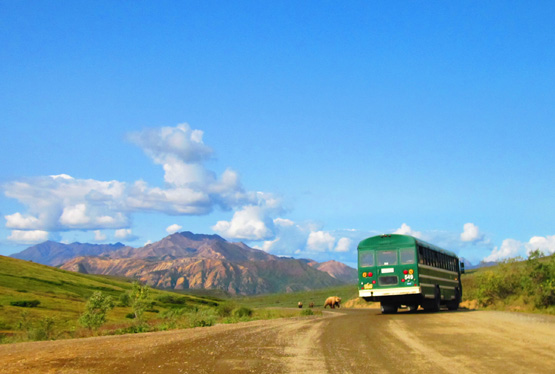
The bears moved into the willows and low bushes to the right while Jim
continued snapping pictures. This one shows the cubs close up:
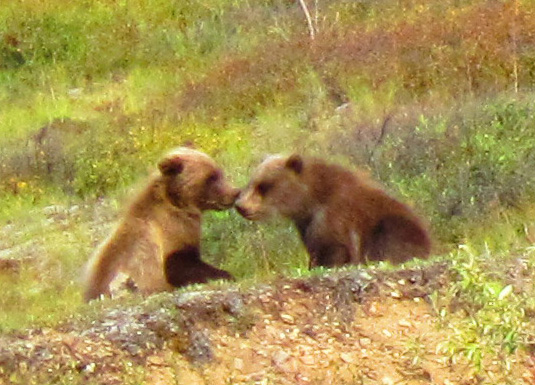
Aren't they adorable? They were born this spring. If they survive, they
will live with their mother for 2½
years before she kicks them out and has more cubs. According to park
researchers, they have only a 35% chance of survival their first year
and 59% the second year. That's pretty low, considering this is a
preserve where they are protected. Someday I'll write a "Bears Rule at
Denali" entry illustrating ways humans must adapt to the bears.
We've got numerous photos of bears (brown and black), moose, caribou,
musk ox, Dall sheep, wolves, sea otters, humpback whales, a fox, a lynx,
bald eagles, grouse, puffins, several other kinds of birds, Arctic
ground squirrels, snowshoe hares, and marmots to show you eventually.
We've seen about as many bears in campgrounds and along the Coastal
Trail, a paved bike-hike path in Anchorage, as we have seen in the wild:
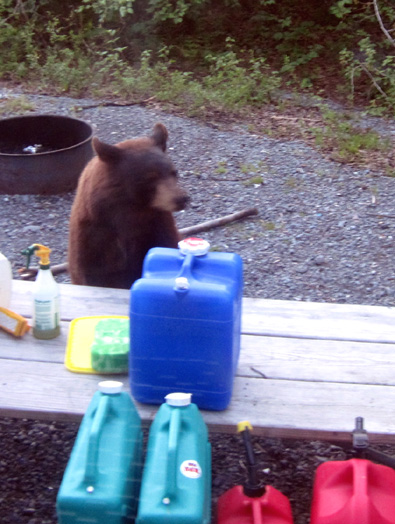
Curious black bear at our campsite in Valdez
(6-15-12). Black bears come in brown, too.
What Alaskans call brown bears are also known as
grizzly bears. They look different.
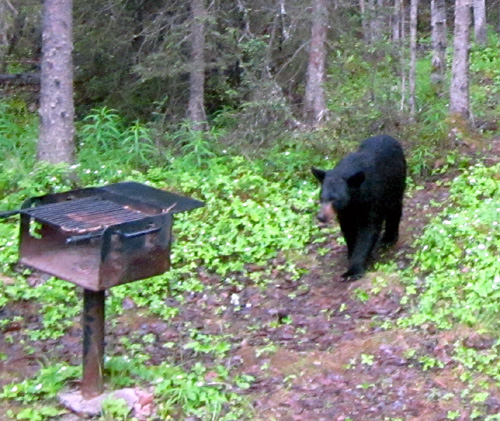
Curious young black bear at our campsite at JBER
(Joint Base Elmendorf-Richardson)
in Anchorage. (6-26-12) Both of these bears appear
to be fairly young but out on their own now.
I'll include some more wildlife pictures in this series of several
pages.
A LITTLE LARGER FORMAT
Since most people have pretty fast computers and internet connections these
days, I'm going to start uploading larger picture files into my Alaska
entries on this website.
These don't have links to make the photos larger;
someday I'll put bigger
pictures on our Picasa site and/or
learn out how to write the proper code on this site so you can just click the
ones you want to see in a larger format.
Even though these pictures are a little larger than the ones I've
usually included on this website, the photos simply don't do justice to the
grandeur of Alaska. I hope they at least give you an idea why I ran out
of superlatives soon after we arrived here!
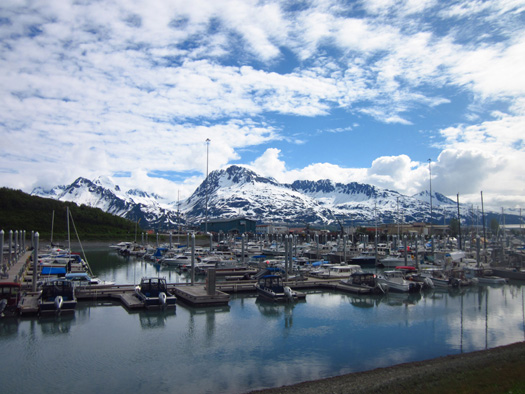
The small boat harbor in Valdez, where snow still
blanketed the mountains at sea level in mid-June.
Valdez, Anchorage, and other areas of Alaska got
record-breaking snow levels last winter. (6-16-12)
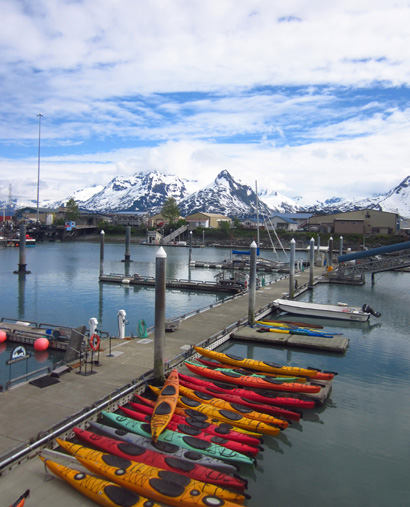
Colorful kayaks in the harbor at Valdez
(6-15-12)
Most of these photos were taken with a new 16-megapixel Sony DSC-H90
Cyber-shot digital camera we bought when we were in Anchorage at the end
of June. The 12-megapixel, 28mm Canon PowerShot A1200 with 4x optical
zoom I'd been using for over a year started making weird noises and I
thought it was about to die.
It didn't and Jim now uses it instead of an
old 5-megapixel Nikon Coolpix.
Jim tried to persuade me to buy a larger, more expensive digital camera with
interchangeable lenses but I thought the16-megapixel, 24mm Sony with
16x optical zoom would be an adequate upgrade for us for less than $200.
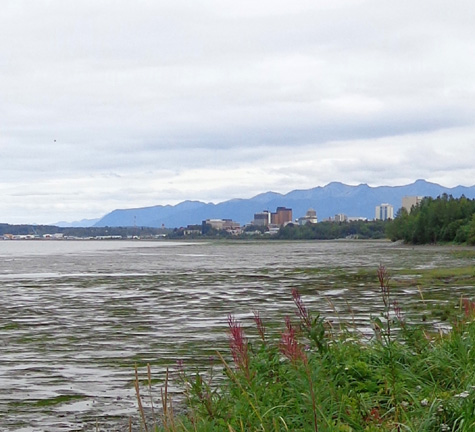
View from the Coastal Trail toward downtown
Anchorage, looking across a bay
in Cook Inlet; the mud flats are very dangerous
when the tide is low like this. (8-24-12)
I was wrong.
The Sony is an improvement and it's fine for landscapes but nowhere near
adequate to get wildlife close-ups. Next time we go to the time and
expense to visit Alaska we'll be bringing a much better camera with a
long zoom lens like so many other tourists have.
Frugality isn't always wise.
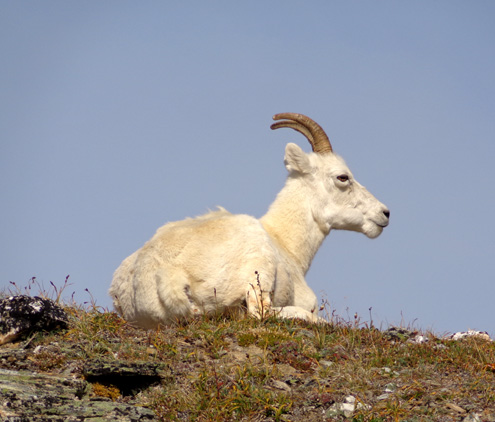
Dall sheep (8-15-12)
However, most of the time I really haven't needed expensive equipment to
get decent shots.
For example, I was so close to the laid-back female Dall sheep above -- about 20 feet away
-- on Mt. Margaret high above the Savage River in Denali NP that a
large zoom lens would have been a detriment. She was fully aware of me
when I sat down to eat a snack nearby but made no attempt to escape my
presence or one-sided conversation with her. Female Dall sheep have
small horns like these. The males' horns are longer and more curved,
similar to Bighorn sheep.
That's just one of several critters I was able to photograph at fairly close
range during one amazing hike. I'll show a few more later.
SOMETHING FOR EVERYONE
Alaska is a magnificent place. It's also huge and many places aren't
accessible by paved roads. Kenai Fjords National Park is one such place.
All but Exit Glacier is
accessible only by boat or plane:
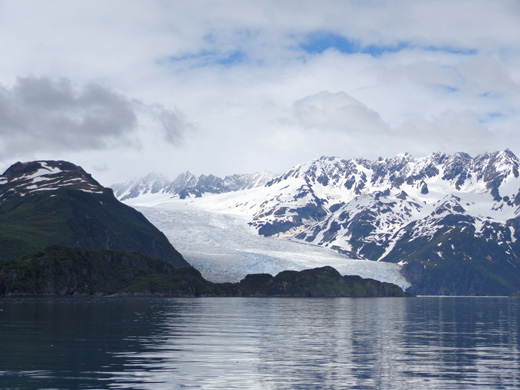
Holgate Glacier, Kenai Fjords
National Park; you need to take a boat or plane ride to see it. (7-9-12)
So far we've visited only the
South Central region of the state and the southern part of the Interior
at Denali National Park. We'll see a little more before we head for the
Lower 48, but not much.
On this trip we haven't gone out into the "bush," as communities
off the road grid are called. Those are accessible by air, water, ATVs,
and dog sleds. Float planes are nearly as common up here as cars and
trucks. There are more small-plane pilots per capita in Alaska than
anywhere else.
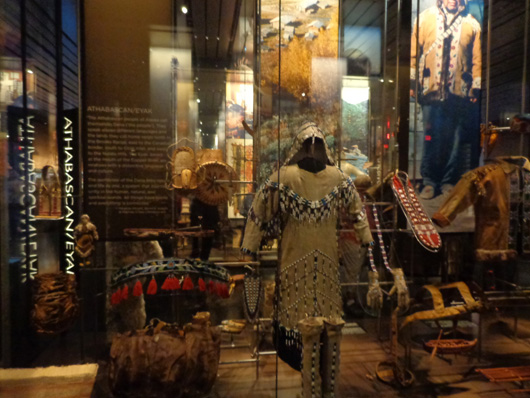
Part of the impressive Native
Alaskan exhibit on one floor of the Anchorage Museum. About a
dozen different Native tribes
have inhabited what is now Alaska for about 14,000 years. (7-23-12)
It's beyond my comprehension how anyone can spend only one or two
weeks on vacation in Alaska and see very much of it. After three months
of wandering around we will have barely scratched the surface of all
there is that we are interested in seeing and doing here.
No wonder visitors keep coming back! We've heard that most people who
are adventurous enough to visit Alaska once either come back repeatedly or
move here.
Now we know why.
DENALI NATIONAL PARK: MY FAVORITE PLACE IN ALASKA
Jim and I spent eleven days in early August at Denali National
Park and had such a fantastic time that we are back again for another
eight days at the end of August/beginning of September.
We aren't as lucky with the weather this time, however.
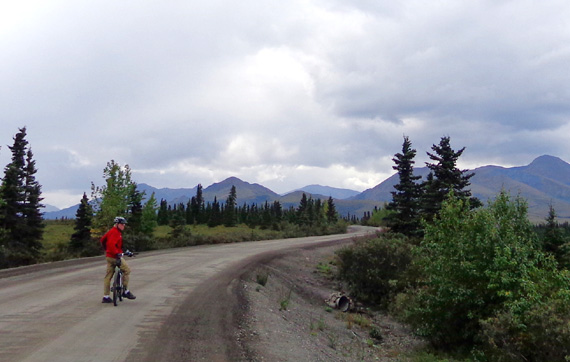
Even on overcast days we get out
to ride and hike -- we just get prettier pictures when it's sunny!
That's Jim on his bike along the park road near Teklanika
Campground. Personal vehicles aren't
allowed very far into the park
but bikes and shuttle buses can go all 92 miles to Kantishna. (8-10-12)
In early to mid-August we had mostly sunny days and were able to see The
High One (that's what "Denali" means in the Native Athabascan language) on several different days in several different locations, which
was a real stroke of luck because 20,320-foot Denali is hidden by
clouds about 70% of the time in the summer.
The campground hosts, bus drivers, and folks who work in or near the
park all summer kept reiterating how lucky we were to have such great
weather. We enjoyed it, not realizing then how different it is when it's
rainy.
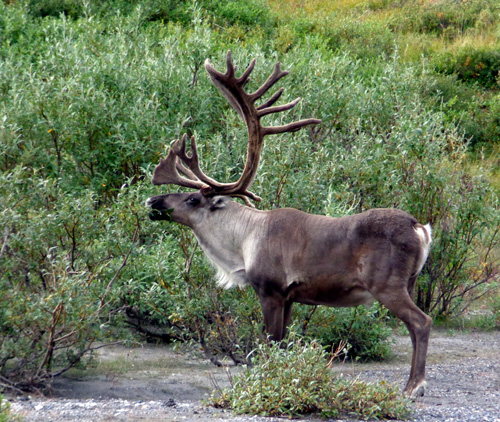
A well-fed male caribou
strips leaves off a willow bush on the Savage River gravel bar.
In the winter he'll mostly subsist on lichen plants he can find under the snow.
Thankfully, he'll shed those
heavy antlers after rutting season is over in a few weeks. (8-14-12)
On our first visit to Denali we found many interesting places to hike
and cycle within the park. Some were in the "front country" (near the
entrance), some in the back country.
We drove our truck 15 miles out to Savage River several times.
We rode shuttle buses into the interior of the park twice, going as
far as Wonder Lake at 85 miles.
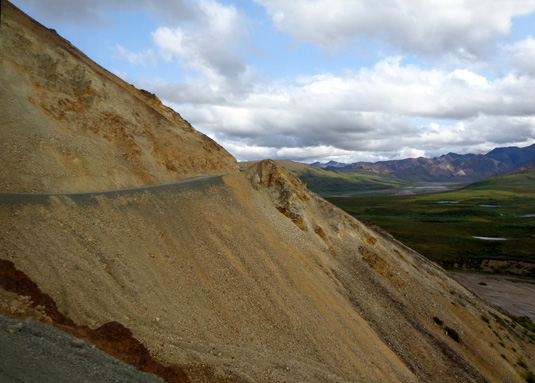
The high, skinny park road at
Polychrome Pass (8-9-12)
During all those excursions we saw lots of
wildlife, including a mama wolf playing with her cub and a lynx prowling
the gravel Savage River bed. There are only about 70 adult wolves spread
out over 6.6 million acres of protected land at Denali so visitors rarely see any wolves
(or lynx); we lucked out in that regard, too.
We also took a flight-seeing tour of Denali, getting very close to the summit
of that behemoth:
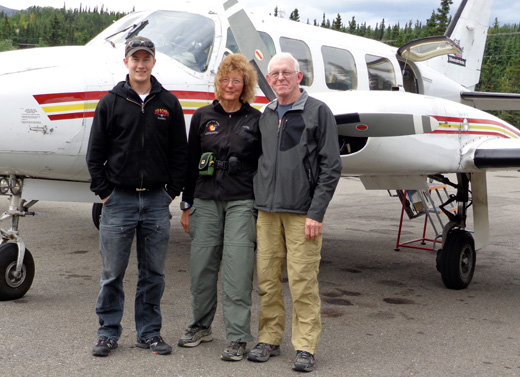
Trent (L), our pilot with Fly
Denali, poses with us after our flight in a sleek Piper Navajo Chieftain
low-wing plane that carries a
pilot and nine passengers. Jim got to sit in the co-pilot's seat.
(8-7-12)
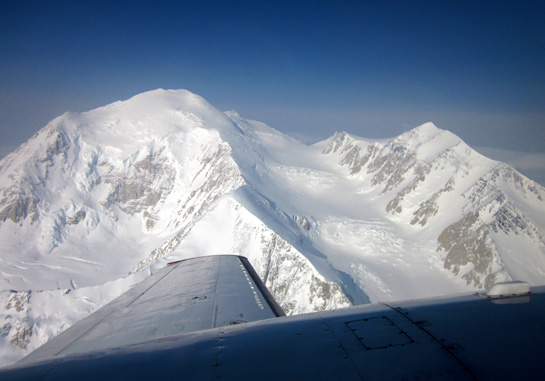
Denali's south (L) and north (R)
peaks; although we look very close -- the camera was not
zoomed in -- the pilot said
we were about a mile away. Jim took this and the next photo. (8-7-12)
We attended interesting ranger talks, visited the park's large kennel
of working sled dogs, watched videos of stunning park scenery at the visitor centers,
and browsed interpretive nature and historic exhibits throughout the park.
We didn't want to leave Denali but we drove back down to Anchorage when the weather forecast
several days of rain. There are more inside activities in the city when it's wet
and full hook-ups are better than "dry camping" (ha!) when it's raining.
We really like
Anchorage, its coast, and its surrounding mountains -- but
it isn't the same as hanging out at Denali when the weather is great.
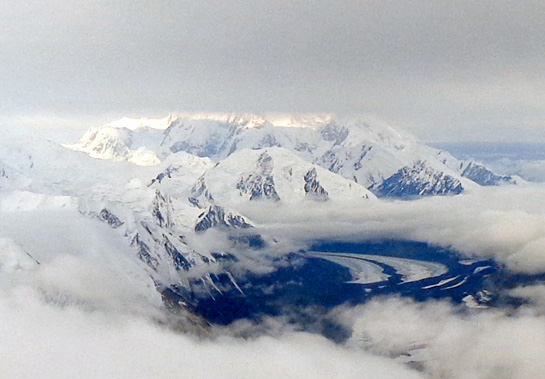
One of the "rivers of ice"
flowing from Denali; clouds quickly move in and out of the Alaska Range (8-7-12)
We were set to head to the Canadian border last Sunday, beginning a
slow journey through the Yukon Territory, British Columbia, and Alberta on our way
back to the Lower 48.
Then we decided we weren't ready to leave Alaska just yet. It has a
grip on us.
So where should we spend some more time? Back in Valdez? Seward? Other places on the Kenai
Peninsula that were wet when we were there -- and are still
wet?? (Rain forests are like that.) Or just stay longer in
Anchorage and do some day trips from there?
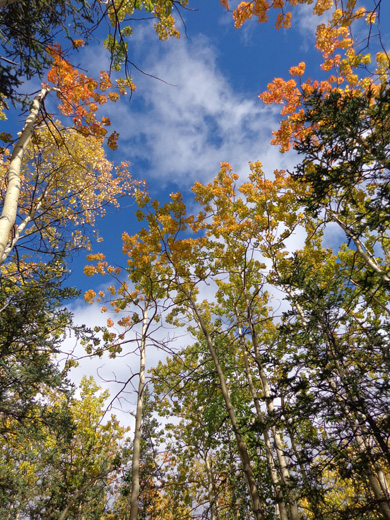
Gold and orange aspen leaves
among the evergreens on the
Rock Creek Trail at Denali;
autumn came quickly! (8-28-12)
A couple days before our planned departure from Alaska we
altered our already-fluid plans yet again and decided to come back to
Denali NP because we had such a great time here earlier in the month and
we heard that the fall colors are
now quite vivid.
Vivid, indeed. It's amazing how much change in leaf color there has
been in just a couple
weeks. In fact, "terminal dust" (the first dusting of snow in
autumn) fell in the park
several days ago, down to about 3,200 feet elevation. Our campground is
about 1,680 feet; we didn't get snow here but temperatures were near
freezing that night.
The snow was beautiful as we drove out to Savage River the next morning:
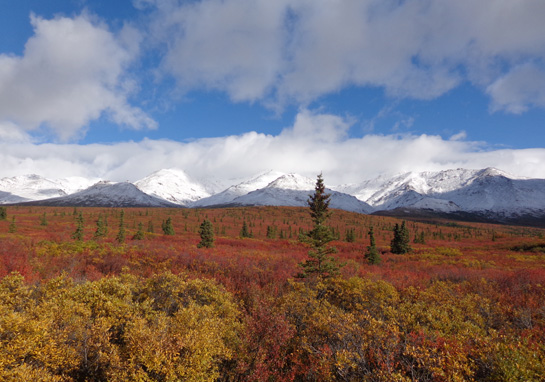
Fresh snow on low peaks in the
Alaska Range in Denali NP (8-28-12)
Most of the new snow melted in a couple days. We know more will come
before long, however. Autumn is an extremely short season in Alaska and
northern Canada. So is spring. What I'd call summer is about two months
long (mid-June to mid-August). Winter lasts forever.
One joke up here is that there are two seasons -- winter and
road construction. I believe it!
Our current plans are
to remain in the park until Labor Day, then spend some time in Fairbanks, Delta
Junction, and Tok as we make our way toward Canada and the Lower 48
during September.
Of course, our itinerary could change many times again depending on the
weather and our whims. As my brother noted recently, "You can do
that." We prefer to avoid driving with a camper in snow
or ice, and freezing temperatures overnight are a challenge with the
water pipes.
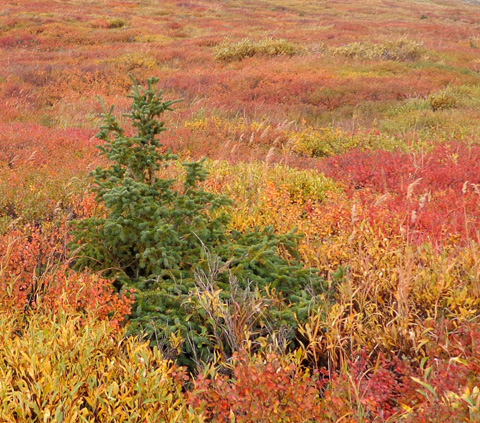
It looks Christmas-y with all the
red and green in the taiga (sub-alpine terrain). (8-30-12)
This has been a very chilly summer where we've been in Alaska, with
most nights in the low to mid-50s F. and temperatures no warmer than the 60s
during the day -- even on sunny days. I can count the number of
days we've had over 70 F. on one hand.
The cool, rain forest summer weather in Anchorage and on the Kenai
Peninsula is very similar to that in coastal cities like San Francisco
and Portland that are much farther south.
"Summer" just doesn't last nearly as long up here.
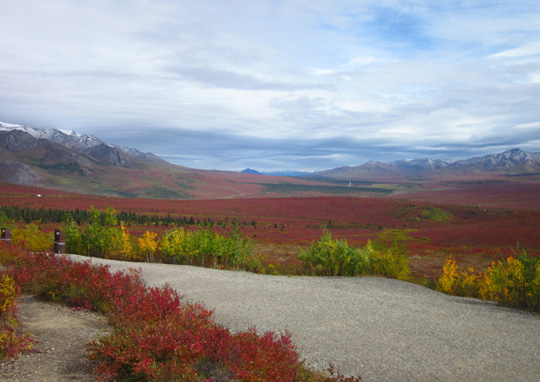
Colorful view from an overlook in
Denali NP while Jim was riding his bike recently (8-29-12)
Meanwhile, much of the Lower 48
continues to swelter in the heat. Even as far north as Rapid City, SD, which we'll visit in
late September, high temps reached 100 F. several days in late August. We hope the northern U.S. states
cool off in the next month.
We aren't acclimated to that much heat after being in
Alaska for three months -- the coldest summer in our lives.
Or to rephrase a saying about San Francisco, the coldest winter we
ever experienced was a summer in Alaska!
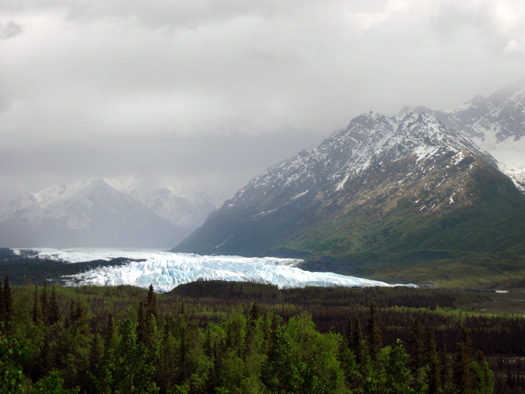
Maybe that's because we've been
around a lot of glaciers . . . This is the
Matanuska Glacier, accessible by
foot from the Glenn Highway near Palmer. (6-17-12)
OK, here and on the next three pages are more photos from this sampling.
I'm spreading them out so they'll load faster. You'll have to wait
until I get around to writing the individual entries to see a bunch
more. Hopefully, that will be sometime during this lifetime!
Photos continued on next page . . .
Happy trails,
Sue
"Runtrails & Company" - Sue Norwood, Jim O'Neil,
and Cody the ultra Lab
Previous
Next
© 2012 Sue Norwood and Jim O'Neil























